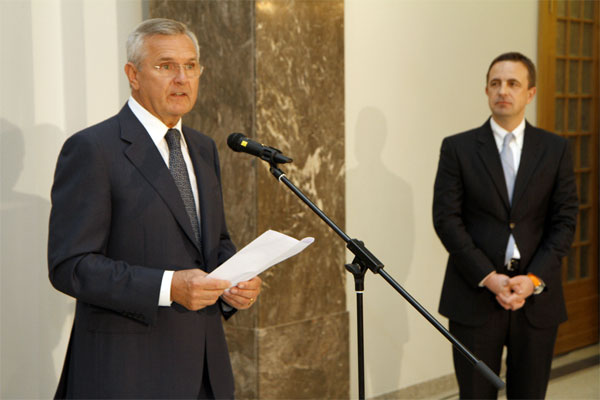
Current Foreign Minister Aivis Ronis (right) listens as Jānis Jurkāns, Latvia’s first foreign minister after the country regained independence, addresses participants during the opening of an exhibit in Rīga marking the re-establishment of the diplomatic corps. (Photo courtesy of the Latvian Foreign Ministry)
When I was lobbying for Latvia’s independence in the late 1980s, I used to tell Washington politicians that the Soviet and Nazi occupations of Latvia were just a brief 50-year interruption in the history of the Latvian Republic.
When Latvia’s independence was restored in 1991, I had the honour of joining one Latvian state institution that had indeed continued to function uninterrupted since 1918. A new exhibit at the Latvian Foreign Ministry shows just how this ministry both survived and renewed itself when Latvia restored its independence 20 years ago.
This 92-year long track record was made possible during the years of occupation by Latvia’s diplomats in exile, most notably Anatols Dinbergs, who maintained Latvia’s de jure status in London and Washington, D.C., for half a century. That is a story in and of itself. But the Foreign Ministry’s new exhibit focuses on the years of 1990–1991, when a new generation of inexperienced but decidedly determined diplomats in Rīga began to rebuild Latvia’s diplomatic corps and re-establish Latvia’s foreign relations with the rest of the world.
Actually, the re-establishment of the independent Republic of Latvia’s Ministry of Foreign Affairs began in May 1990, 15 months before Latvia’s independence was “re-recognized” internationally. Following the May 4, 1990, Supreme Council vote to restore independence, a new government was formed under the leadership of Prime Minister Ivars Godmanis. With the choice of Jānis Jurkāns as the new foreign minister, the “old” Foreign Ministry began to reconstitute itself.
The young men and women who assumed diplomatic duties at the small but eclectically elegant building at 11 Pils St. in Rīga’s Old Town had no formal training and no ties to the former Soviet regime that had previously occupied the building. They had a few old typewriters, some telephones of questionable reliability and a telex machine that enabled them to make limited contact with the outside world. What they didn’t lack was dedication, patriotism and a fierce commitment to learn the nuts and bolts of their newly assumed diplomatic craft.
The exhibit in the vestibule of the Foreign Ministry displays some of those phones, as well as other seemingly ancient artifacts from 20 years ago, including passports, diplomatic notes, photographs and other ministry memorabilia. You can see the ministry’s first “mobile” phone, a bulky Panasonic that was the size of a small toolbox and weighed several kilos.
The remarkable thing is that while the glass cases reveal the stuff of the past, many of the people who used that stuff are still with the ministry today. In fact, Latvia’s last two foreign ministers, Aivis Ronis and Māris Riekstiņš, both began their careers in those early years. So did Latvia’s present Defence Minister Imants Lieģis.
Fresh-faced foreign service officers like Mārtiņš Virsis, Ints Upmacis, Ivars Pundurs, Alberts Sarkanis, Argita Daudze, Normans Penke, Aivars Vovers and Atis Sjanītis, who were opening embassies and establishing diplomatic contacts in the early ‘90s, are today experienced elder statesmen with ambassador rank in Latvia’s diplomatic corps. If it seems like Anita Prince, Bonifācijs Daukšts, Klāvs Sniedze and Irēna Putniņa have been with the Foreign Ministry forever, you’re probably right. (For anyone under the age of 20 today, that is forever.)
Sandra Kalniete was the ministry’s first chief of protocol, went on to become ambassador, foreign minister, and European Union commissioner, and today serves as a member of the European Parliament.
One of the glass cases displays Foreign Minister Jurkāns’ first diplomatic passport with the number 00003 (No. 00001 was given to Popular Front leader Dainis Īvāns, 00002 to Chairman of the Supreme Council Anatolijs Gorbunovs, and 00004 to Prime Minister Ivars Godmanis). The blanks for these original diplomatic passports had to be shipped to Rīga from the Latvian Legation in Washington, D.C., where they had been safeguarded for half a century.
In his recollections as the first foreign minister of the renewed ministry, Jurkāns also gives generous credit to Latvia’s leading exile organisation, the World Federation of Free Latvians (Pasaules brīvo latviešu apvienība), and its leaders, Gunārs Meierovics, Jānis Ritenis and Egils Levits. They not only helped their Rīga colleagues with the re-establishment of the diplomatic corps and sundry legal documents, but also went on to become ministers in ensuing Latvian governments. The stately conference room next to the ministry’s vestibule is named after Meierovics’ father, Latvia’s first foreign minister, Zigfrīds Anna Meierovics.
The exhibit includes a 52-minute documentary film called “The Renewers,” which focuses on the recollections and life stories of 16 individuals who played key roles in re-establishing the work of the Foreign Ministry in 1990 and 1991. But that’s only a tribute to the last 20 years. The rest of the story, I’m happy to say, is to be continued.
© 1995-2025 Latvians Online
Please contact us for editorial queries, or for permission to republish material. Disclaimer: The content of Web sites to which Latvians Online provides links does not necessarily reflect the opinion of Latvians Online, its staff or its sponsors.





Great write-up. I will try to drop in at 11. Pils iela.
Very interesting reading to a foreigner living 16 of those 20 years in Latvia:) Would like to read more of this in English. Thank you – and make sure it is publicized, somehow!
To Henrik: you can find this and other articles in English in http://www.latvia.lv, which is constantly updated by the Latvian Institute.